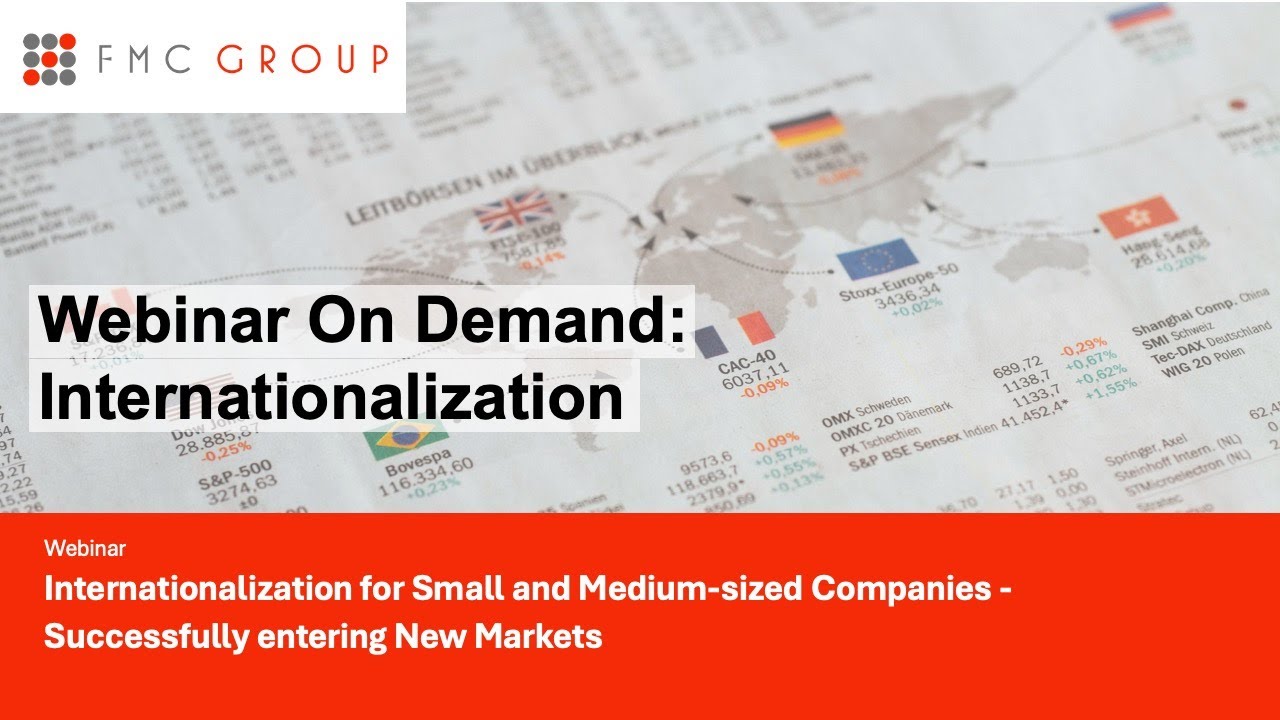
Internationalization Strategy
Internationalization Strategy as the Key to Sustainable Corporate Growth
A successful corporate strategy must include sustainable growth targets. In this context, internationalization with the aim of expanding the company’s global footprint is an indispensable strategy component and growth guarantor.
The FMC Group supports you in reviewing your internationalization readiness and capability. We show you the right way to master new market entries successfully to exploit additional growth potential.
In our view, the following steps are essential for a successful internationalization strategy. With our many years of practical experience, we can advise and accompany you in these steps:
Internationalization Capability Workshop
In an approx. one-day workshop, in which your most important key persons (recommendation: max. 12 persons) can participate, we discuss the capabilities and prerequisites in your company to be able to expand successfully into new international markets.
In the workshop, we explain the important steps an internationalization project has to go through and check together per module if the following points are present in your company and enable a successful new market entry:
- Sufficient skills and resources,
- Establishment and process organization (logistics, supply chain, IT, etc.),
- market position and business model to the
- cultural understanding in the international target markets
The workshop concludes with the definition of strategic goals and the description of measures to be derived.
The workshop will be led by Hans Sondermann (Partner FMC Group), who, with more than 30 years of professional experience as CSO of two world market leaders in the industrial sector, has successfully implemented the globalization strategies of these companies and driven the continuous expansion of the “Global Footprint”.

Identification of new target markets
The first step towards successful internationalization is the identification and selection of suitable target markets. Corresponding market analyses are essential in order to know their strengths, weaknesses as well as opportunities and risks.
Based on your product and service portfolio, we focus on the systematic analysis of the following factors:
Focus of the market analysis
- Market size
- Market potential
- Industry and customer segmentation
- Market attractiveness & competitiveness of your products and services
- Competitive situation
- The regulatory environment (political stability, currency risks, complexity of business operations, legal certainty and IP protection, etc.).
- Availability of local resources
– HR (availability of qualified employees
– Infrastructure (logistics etc.)
– Possible partner and distributor networks, etc.
- Business ranking (economic KPIs of the target market, difficulty of business activity)
- Investment ranking of international investors in the target market
- Cultural Fit
Selection of the target market
Due to the usually limited resources of a company, not all attractive target markets can be tackled at the same time, thefore we focus on the markets which promise the fastest market entry success.
For this purpose, we build up a balanced scorecard – a ranking where the focal points are weighted according to their importance for your company. Preferences from your corporate cultural values are also included.
Adaptation of the business model in the target market
As a rule, the business models applicable to your core markets cannot be transferred 1:1 to a new target market but require adaptation to the local conditions in the new target country, which is the subject of the third module:
Based on the results of the market analysis of the target country as well as the SWOT analysis (evaluation of strengths, weaknesses, threats and opportunities) regarding the marketing of your product and service offering, we create an adapted business model tailored to your company.
The FMC Group uses the “CANVAS Business Model” as its methodology. It is easy to understand and offers a holistic approach in the consideration of all relevant aspects of a business model as well as their interconnections.
We provide you with answers to the following 9 building blocks:
Value proposition
Defining the products and services and the added value they contain that are geared to the needs of customers in the target market and positively differentiate them from the offerings of competitors.
Customer segments
Determine key strategic customers, customer segments and industries, that hold out the prospect of the greatest realizable sales potential.
Customer relations
Description of customer relationships, how the company interacts with its customers in the target market and what relationships it builds with them to satisfy their expectations and needs.
Distribution channels
From this perspective, we provide recommendations for determining the communication and distribution channels for how the company sells its products or services to customers. Examples include online stores, retail stores, distribution partners or direct sales.
Revenue sources
This module describes how the company generates sales and earnings in the target market. Examples include selling products, selling service contracts, charging licenses/fees, selling consulting, etc.
Key Resources
This element describes which key resources are required and, if necessary, need to be built up so that the company can implement its business model in the target market and fulfill its value proposition to the customer. Examples include employees, capital, IT and technology partnerships.
Key activities
Description of all activities that the company must perform in order to implement its business model. Examples are production, marketing, sales or customer service.
Key partner
In this module, it is important to determine which partners the company needs to operate its business. These can include, for example, suppliers, sales partners or technology providers.
Cost structure
Here, all costs incurred to realize the business model are compiled and estimated, e.g. employee costs, production costs, marketing costs or operating costs.
Together with the revenue sources block, profitability calculations can be derived.
Customized market entry strategy
The business model developed and aligned with the target market provides the framework for the market entry strategy and the measures to be derived in the following, which are aimed at achieving rapid market shares and overcoming existing market entry barriers.
We advise and support you with the following building blocks of your market entry strategy:
Based on our market analyses, we provide decision recommendations,
- whether the entire market or individual industries are to be served,
- whether the core business should focus on OEMs or end customers,
- which are the most potential key customers and industries and
- which quality segment (high quality or low cost products) is to be served.
Our decision recommendations result from the market analysis results and include:
- Customer identification and listing
- Regional customers and industry concentration
- Opportunity Screening, etc.
Definition of the product and service portfolio
We support the positioning of your products and services in the target market by examining and evaluating the criteria that describe the market attractiveness and competitive strength in the target customer segments. For the documentation we make use of the Boston-Consulting Matrix.
Determination of the distribution channels
Deciding on the right distribution channels follows the objective of maximizing customer attention to the company and its products and ensuring customer satisfaction in terms of advice, fast and reliable delivery.
In doing so, we use our market analyses to evaluate the distribution channels
- Direct Sales
- Sales partner
- Dealers / Distributors
- E-commerce
- Combinations of the above distribution channels
and suggest the most suitable distribution channel for you.
If you wish, we can support you in your search for suitable partners in the target market, depending on your preferred sales channel.
Design of the delivery logistics
Crucial, but unfortunately often neglected, is the early analysis of the infrastructure in the target market in terms of stocking and supply logistics with the objective of availability and fast customer delivery (“fast last mile”).
We support you with an infrastructure map showing locations of
- Airports, highways and rail lines,
- Logistics hubs
- Suitable logistics service providers and partner networks, but also
- Competitor
and can therefore also be an important decision-making aid for your own choice of company location.
Determining the price strategy and conditions policy
A successful price and conditions strategy takes into account both the competitive situation and the needs of the customer.
We support you with the necessary information, such as customary market
- Terms of payment
- Payment morale
- Invoicing (showing discounts, etc.)
- Price sensitivity
Market communication strategy
(Advertising campaigns, social media, trade fairs, etc.)
Marketing usually requires both content-related and monetary support from the company’s head office at the beginning, as usual marketing budgeting, e.g. in % of sales, would not be sufficient in the first years to achieve the very important early customer perception in the market. We support the creation of marketing plans that are in line with the goals.
Choosing the right legal form of a company
We support you in choosing the appropriate legal form of company that will enable you to enter the market in the target market safely, quickly and without barriers.
On-site implementation support
The success of your market entry depends crucially on qualified employees and well-functioning processes, especially in the start-up phase of your presence in the target market. With our long industry and market experience as well as our local networks, we offer our clients support on an ad hoc project basis for their specific local requirements.
Depending on the target country, we offer different services:
Employee Leasing
Hiring of local employees without own local company
Recruitment
Search and selection of qualified employees
Company formation
Choice of the appropriate legal form and official registration
Location search
Based on the results of the market analyses, we suggest suitable locations for your start-up and assist in the search/selection/purchase/lease of office buildings, warehouse space, etc.
Partner search
Auditing and selection of suitable distribution partners, logistics service providers, suppliers, marketing agencies, etc.
Financial services
Financial management, accounting, payroll, etc.
Legal Services
Assistance with contract law, labor law, commercial law, etc.
For a detailed and specific description of these on-site support activities, please refer to the comprehensive FMC Group Service Offerings.
Accompanying organizational development
A successful start in a new market demands a high level of adaptability to a foreign work and business relationship culture from the employees involved and from the organization. The ultimate goal of our “Organization and People Development” module is to create a locally effective and high-performing organization that can adapt to changes in the external environment while maintaining a positive work culture and sustainably maximizing employee engagement and productivity.
With our local expertise, we help you analyze the current organizational structure and culture, both locally and at the interface to the supporting headquarters organization, identify weaknesses and opportunities for improvement, plan changes, and implement corresponding measures.
Our range of services includes:
- Advice on modeling the local target organization as well as the interfaces to the central headquarters organization
- Identification of personnel development needs
- Creation of individual personnel development plans (training, mentoring, networking, coaching, etc.)
- Creation of efficient communication plans and channels
- Transfer of intercultural knowledge with reference to the target market



